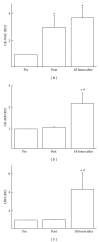Chronic inflammation and neutrophil activation as possible causes of joint diseases in ballet dancers
- PMID: 24701035
- PMCID: PMC3950498
- DOI: 10.1155/2014/846021
Chronic inflammation and neutrophil activation as possible causes of joint diseases in ballet dancers
Abstract
Herein, we investigated the effects of a ballet class on the kinetic profiles of creatine kinase (CK) and lactate dehydrogenase (LDH) activities, cytokines, complement component 3 (C3), and the concentrations of immunoglobulin (Ig), IgA and IgM, in ballerinas. We also verified neutrophil death and ROS release. Blood samples were taken from 13 dancers before, immediately after, and 18 hours after a ballet class. The ballet class increased the plasma activities of CK-total (2.0-fold) immediately after class, while the activities of CK-cardiac muscle (1.0-fold) and LDH (3.0-fold) were observed to increase 18 hours after the class. Levels of the TNF-α , IL-1β, IgG, and IgA were not affected under the study conditions. The exercise was found to induce neutrophil apoptosis (6.0-fold) 18 hours after the ballet class. Additionally, immediately after the ballet class, the neutrophils from the ballerinas were found to be less responsive to PMA stimulus.
Conclusion: Ballet class was found to result in inflammation in dancers. The inflammation caused by the ballet class remained for 18 hours after the exercise. These findings are important in preventing the development of chronic lesions that are commonly observed in dancers, such as those with arthritis and synovitis.
Figures




Similar articles
-
A Single Bout of High Heels Dancing Causes an Increase in Circulating Markers of Muscle Tissue Degradation and MMP-3 in Young Healthy Women.Transl Sports Med. 2023 Jun 1;2023:8852889. doi: 10.1155/2023/8852889. eCollection 2023. Transl Sports Med. 2023. PMID: 38654916 Free PMC article.
-
Ballet dancers cardiorespiratory, oxidative and muscle damage responses to classes and rehearsals.Eur J Sport Sci. 2014;14(3):199-208. doi: 10.1080/17461391.2013.777796. Epub 2013 May 17. Eur J Sport Sci. 2014. PMID: 23679120
-
Inflammatory response and neutrophil functions in players after a futsal match.J Strength Cond Res. 2012 Sep;26(9):2507-14. doi: 10.1519/JSC.0b013e31823f29b5. J Strength Cond Res. 2012. PMID: 22067240
-
Pathoanatomy of posterior ankle impingement in ballet dancers.Clin Anat. 2010 Sep;23(6):613-21. doi: 10.1002/ca.20991. Clin Anat. 2010. PMID: 20821398 Review.
-
Jumping in Ballet: A Systematic Review of Kinetic and Kinematic Parameters.Med Probl Perform Art. 2021 Jun;36(2):108-128. doi: 10.21091/mppa.2021.2011. Med Probl Perform Art. 2021. PMID: 34079984
Cited by
-
Dance Training Improves Cytokine Secretion and Viability of Neutrophils in Diabetic Patients.Mediators Inflamm. 2019 Nov 20;2019:2924818. doi: 10.1155/2019/2924818. eCollection 2019. Mediators Inflamm. 2019. PMID: 31827375 Free PMC article.
-
Lymphocyte activation after a high-intensity street dance class.PLoS One. 2020 Sep 21;15(9):e0239516. doi: 10.1371/journal.pone.0239516. eCollection 2020. PLoS One. 2020. PMID: 32956398 Free PMC article.
-
Features of Neutrophils From Atopic and Non-Atopic Elite Endurance Runners.Front Immunol. 2021 Jun 11;12:670763. doi: 10.3389/fimmu.2021.670763. eCollection 2021. Front Immunol. 2021. PMID: 34177910 Free PMC article.
-
Neutrophil Migration and Adhesion Molecule Expression after Acute High-Intensity Street Dance Exercise.J Immunol Res. 2018 Jul 8;2018:1684013. doi: 10.1155/2018/1684013. eCollection 2018. J Immunol Res. 2018. PMID: 30069484 Free PMC article.
-
A Single Bout of High Heels Dancing Causes an Increase in Circulating Markers of Muscle Tissue Degradation and MMP-3 in Young Healthy Women.Transl Sports Med. 2023 Jun 1;2023:8852889. doi: 10.1155/2023/8852889. eCollection 2023. Transl Sports Med. 2023. PMID: 38654916 Free PMC article.
References
-
- Strassel JK, Cherkin DC, Steuten L, Sherman KJ, Vrijhoef HJM. A systematic review of the evidence for the effectiveness of dance therapy. Alternative Therapies in Health and Medicine. 2011;17(3):50–59. - PubMed
-
- Keogh JWL, Kilding A, Pidgeon P, Ashley L, Gillis D. Physical benefits of dancing for healthy older adults: a review. Journal of Aging and Physical Activity. 2009;17(4):479–500. - PubMed
-
- Khan K, Brown J, Way S, et al. Overuse injuries in classical ballet. Sports Medicine. 1995;19(5):341–357. - PubMed
-
- Hillier JC, Peace K, Hulme A, Healy JC. MRI features of foot and ankle injuries in ballet dancers. British Journal of Radiology. 2004;77(918):532–537. - PubMed
-
- Ritter S, Moore M. The relationship between lateral ankle sprain and ankle tendinitis in ballet dancers. Journal of Dance Medicine & Science. 2008;12(1):23–31. - PubMed
Publication types
MeSH terms
Substances
LinkOut - more resources
Full Text Sources
Other Literature Sources
Medical
Research Materials
Miscellaneous

